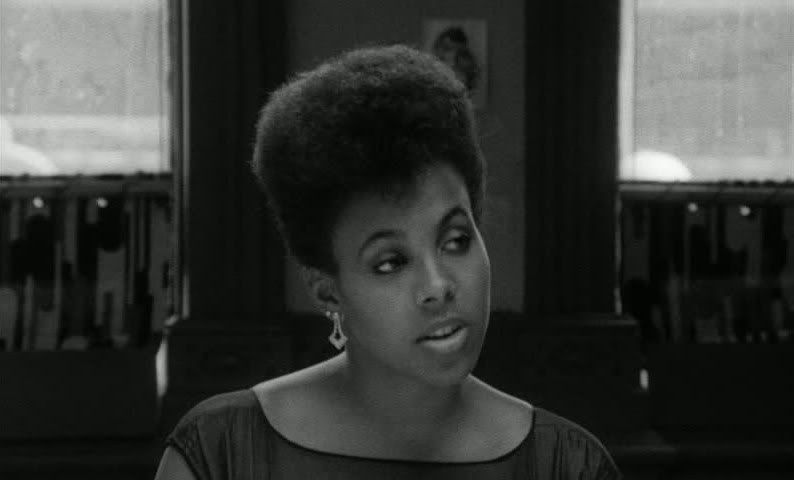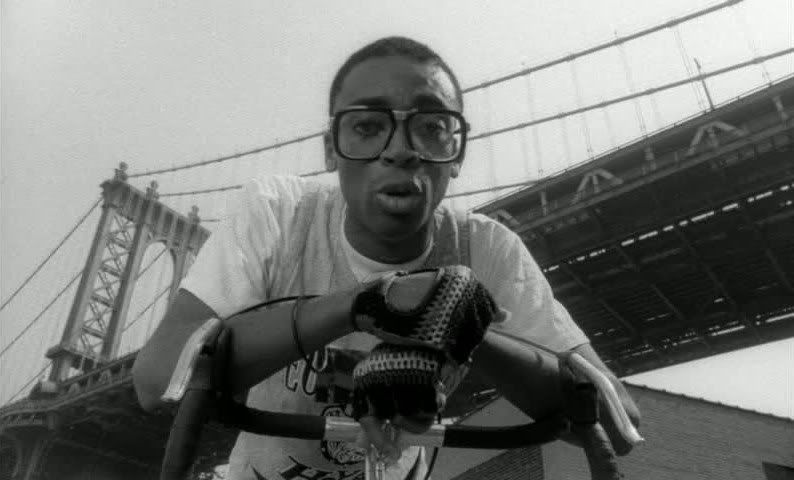
Spike Lee's debut feature, She's Gotta Have It, is a quirky, interesting view of sexuality and the double standards applied to men and women. Nola Darling (Tracy Camilla Johns) is sexually liberated, and she makes no secret of the fact that she's not a one-man woman. She's going out with three guys at once: the narcissistic, shallow Greer (John Canada Terrell), the earnest Jamie (Tommy Redmond Hicks), and the brash, funny Mars (Lee). The guys think she's a slut, or a nymphomaniac, that there's something wrong with her, even though of course they're all just as promiscuous; when Nola rejects Mars one night, he immediately dials up another girl and tells her how much he misses her. Nola's simply refusing to live by anyone else's rules, refusing to want or to do what she's supposed to do just because someone tells her to. "I don't believe in regrets," she says, and she seems to mean it. She's her own person, resisting conventional ideals like marriage and monogamy.
The first shot of Nola shows a bed with the covers rustling, as though in the midst of passionate sex, but then Nola sits up, alone, addressing the camera. It's an appropriate introduction for a character who's often defined by others (including Lee as the director, at times) strictly in terms of her polymorphous sexuality, but who just wants to be appreciated on her own terms, not judged just because she enjoys sex and doesn't want to be tied down to any one man. Lee probes this icon of female sexuality with a pseudo-documentary style in which Nola and her three men all talk directly to the camera, as does Nola's estranged friend Clorinda (Lee's sister Joie), who's disgusted by her friend's attitude towards sex, and the lesbian Opal (Raye Dowell), who wants Nola as badly as the men do. As Nola herself explains towards the end of the film, all of these people might understand parts of her, but they don't understand the full woman, and they all try to get her to conform to a role that she's not ready to fill.
The multiple perspectives and direct, casual addresses to the camera give the film a loose, jazzy vibe. Indeed, it's a pretty loose film all around, as one would expect from an early feature. Lee's style is already vibrant and punchy, scattering the film with stray fragments of New York street photography to ground the story in his beloved hometown. But the performances are unfortunately inconsistent, and the direct addresses are often awkward and poorly acted. Even Johns, who is a charming and expressive screen presence, with a radiant smile and an ability to say a lot with her eye movements, is mostly flat in her line readings. Terrell is probably even worse, though at least it seems like his character is supposed to be a stiff killjoy. Lee himself gets an easier time, basically playing his own goofy self, hiding behind tremendous glasses, wearing his grungy, scuffed-up sneakers even during sex. At one point, Mars excitedly raps with Jamie about a Knicks game, channeling the director's well-known love of basketball, ripping on Larry Bird — "the ugliest motherfucker in the NBA!" — and briefly finding some common ground with the otherwise aloof Jamie. Mars' enthusiasm is so infectious, his character so outrageously funny, that it's easy to miss the somewhat hateful things he says about Nola, slipped seamlessly into his patter.

As funny as Lee is, Greer is the richest target of mockery in the film, providing comic relief with moments like his earnest monologue about the "three penis monster." The best scene, though, is the one where Nola seduces him and he responds by slowly, methodically undressing, carefully folding his clothes item by item as he takes them off, smoothing out the wrinkles, taking so long that by the time he's ready to get into bed Nola is bored and frustrated, rolling her eyes. Lee deliberately extends the scene, letting Greer's fastidious stripping play out in plodding real time, the joke getting funnier and funnier the longer he stretches it out. In scenes like this, Lee's goofy humor and stylistic restlessness recalls early Woody Allen, an obvious reference point for this film.
She's Gotta Have It is much less assured in its serious moments. A sex scene between Jamie and Nola late in the film is especially uncomfortable because it pretty much plays out like a rape except that Nola, uncharacteristically, submits to it. It's an ugly scene that seems to undermine Nola's sexual independence and leaves a sour taste in one's mouth during the film's final act, which stutters to a halt rather than really wrapping up the film's many provocative threads.
The film's flaws are indicative of a young filmmaker just finding his voice, but in many other respects Lee is already fully formed here. His love of New York and his love of the cinema shine through in a big way, especially during a playful and unexpected musical interlude, in bright color, when Jamie has some dancers perform an allegorical love story for Nola as a birthday present. It's a bit of a French New Wave meta diversion that briefly hints at the bold colors to come in Lee's later films. But the film's black-and-white cinematography is actually one of its best assets, switching between a functional, low-key style for the "documentary" sequences and gorgeous, stylized noir-esque imagery during the film's lushly erotic sex scenes. In these scenes, naked bodies seem to shine brightly against a black background, with candlelight flickering over bare skin and every intimate contact charged with pleasure. The film's occasional eroticism jars against its goofier tendencies — never more so than when Lee's Mars is involved in the sex — but this sensual aesthetic is actually a perfect way to privilege the perspective of Nola, who genuinely loves and enjoys sex, having fun with her body and her lovers. She's Gotta Have It is an interesting early work from Lee, a bold, provocative, uneven examination of sex and gender that's as funny as it is thought-provoking.

4 comments:
Budgeted at less than $200,000 SHE'S GOTTA HAVE IT was a stylistically and thematically audacious debut for Lee, which even to this present date on balance would still rate as one of his four best films with DO THE RIGHT THING, MALCOLM X and BAMBOOZLED. There's a socumentary feel (as you note in your comment about female sexuality) and there most certainly is a jazzy feel to the piece, which is rooted in the hometown aura. I agree the performances are uneven and are no doubt the result of this being Lee's very first effort. Yep, the color musical interlude is dazzling and the entire black and white tapestry yields a noirish underpinning. It was a very well-received first effort, and one that was uncorrupted by some of the commercial concessions that dot some of his later work.
As always a terrific essay here!
Thanks, Sam. It's clearly the work of a starting director and some of its imperfections stem from that - but so does its refreshing looseness and charm, so it's a bit of a wash in that respect. Definitely a fascinating debut.
That's a great review of the film!
I remember reading an interview with Spike Lee where he said he's astounded at how the movie's become such a feminist icon. The fact that he didn't set out to create that message somehow makes the whole thing even more endearing.
I reviewed it here, if you're interested: http://theoncominghope.blogspot.com/2012/03/hope-unease-and-disappointment-in.html
Post a Comment